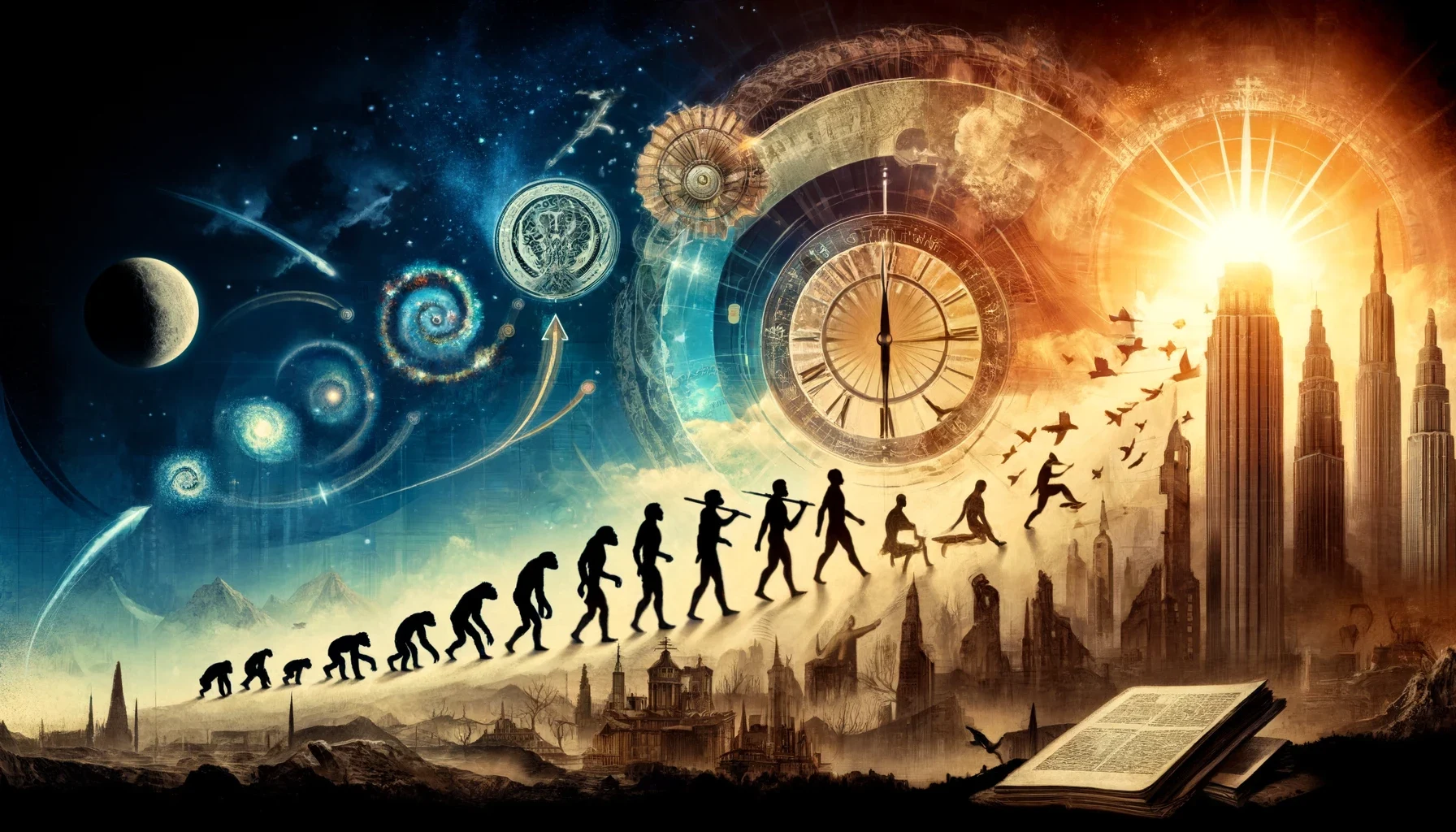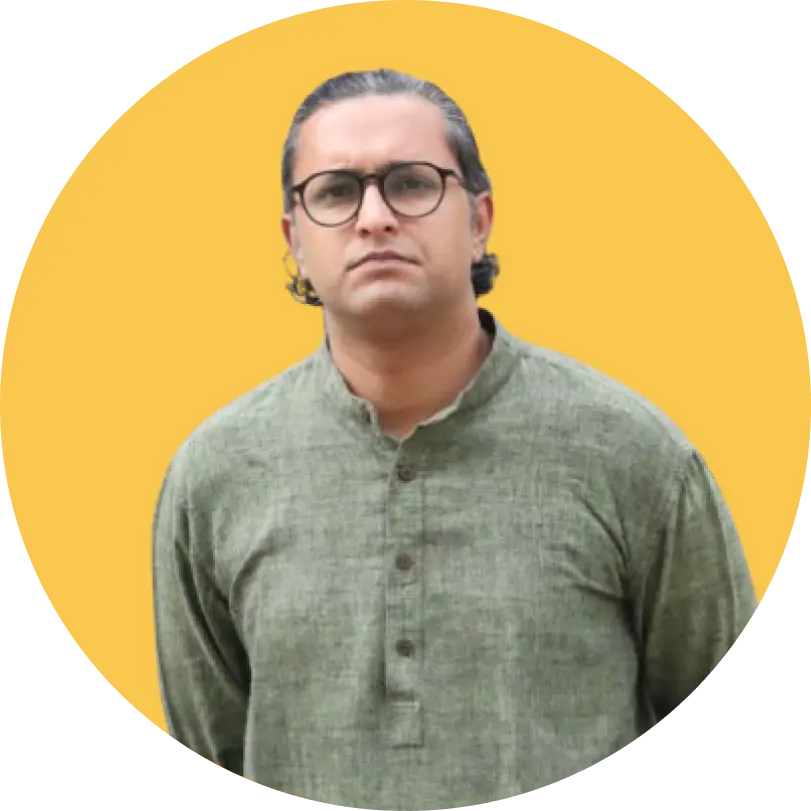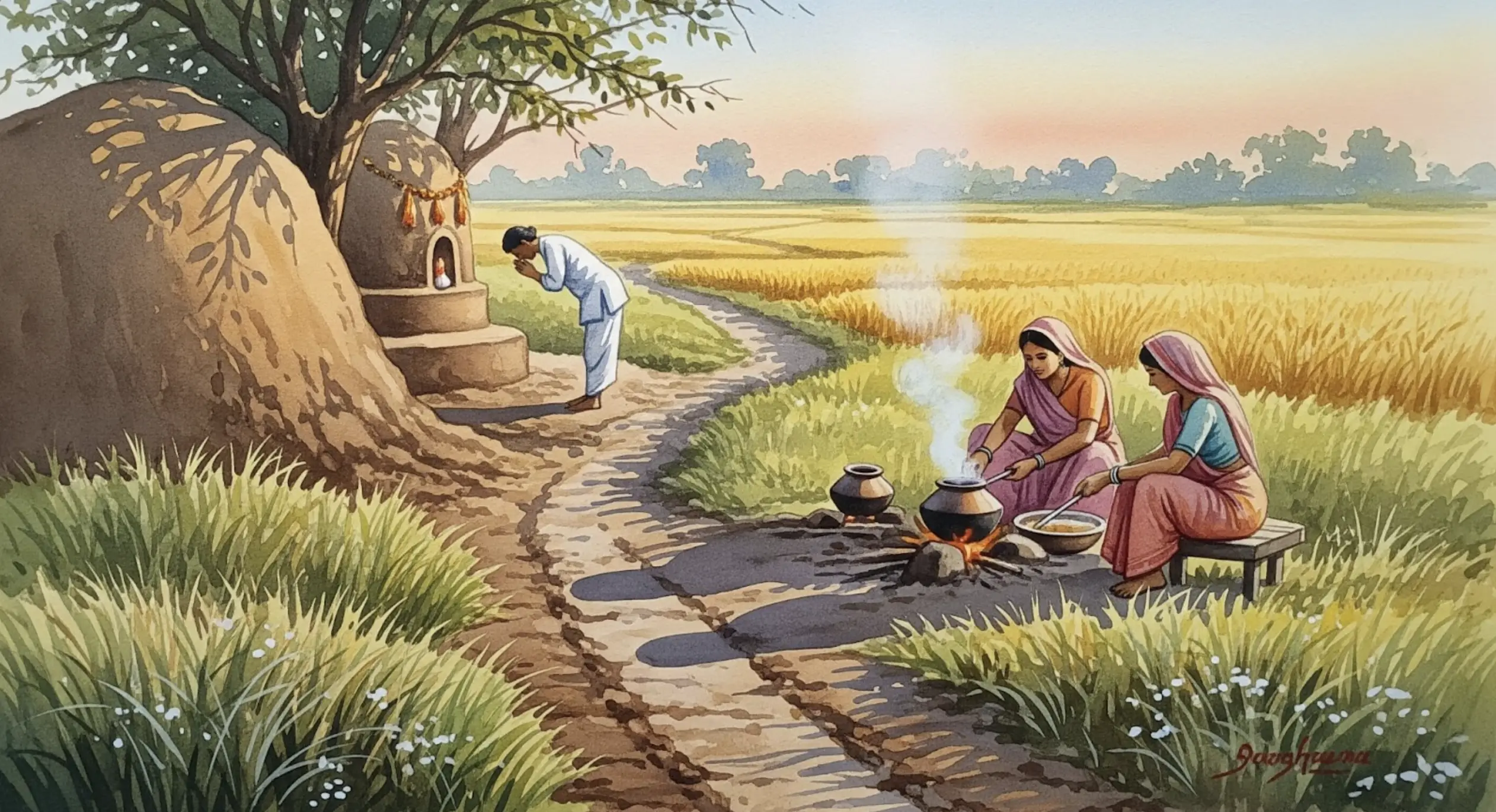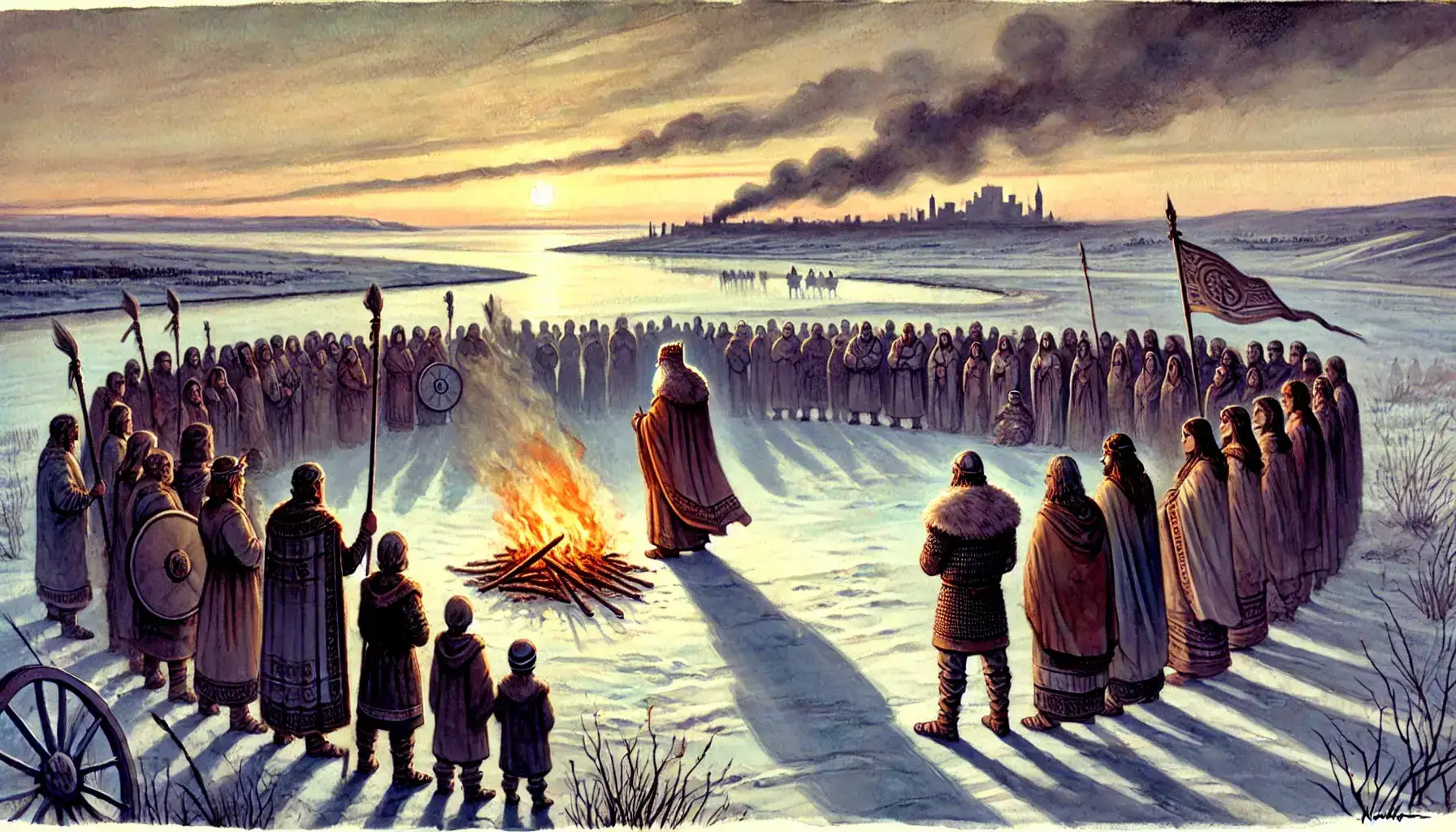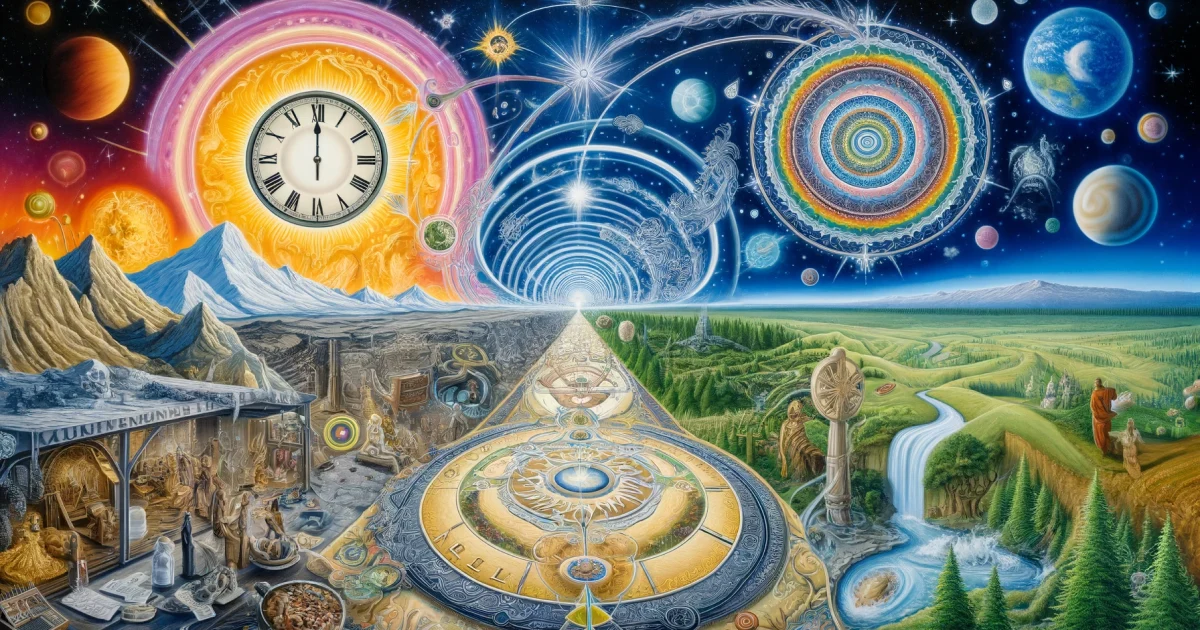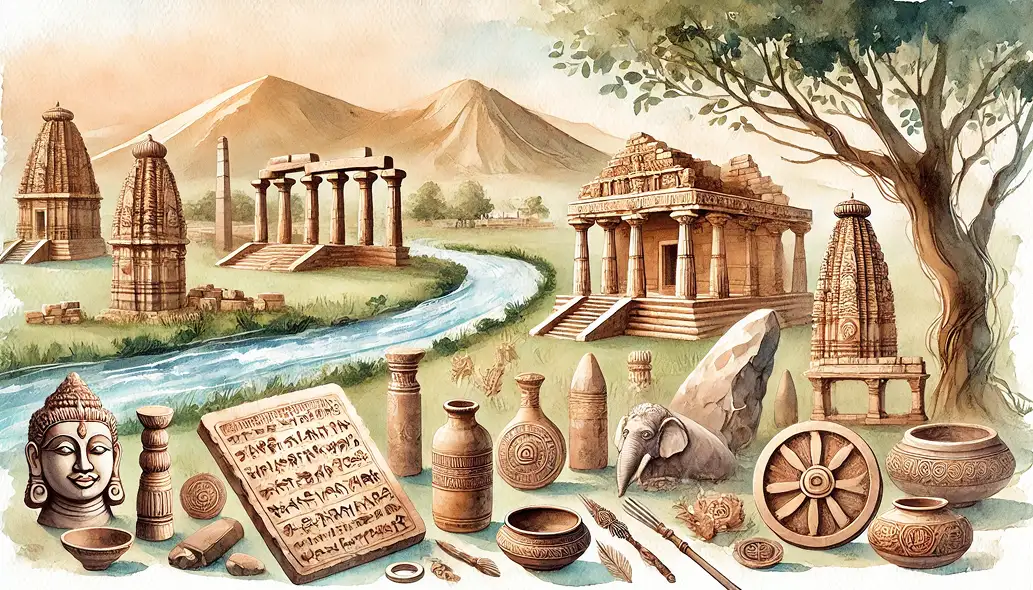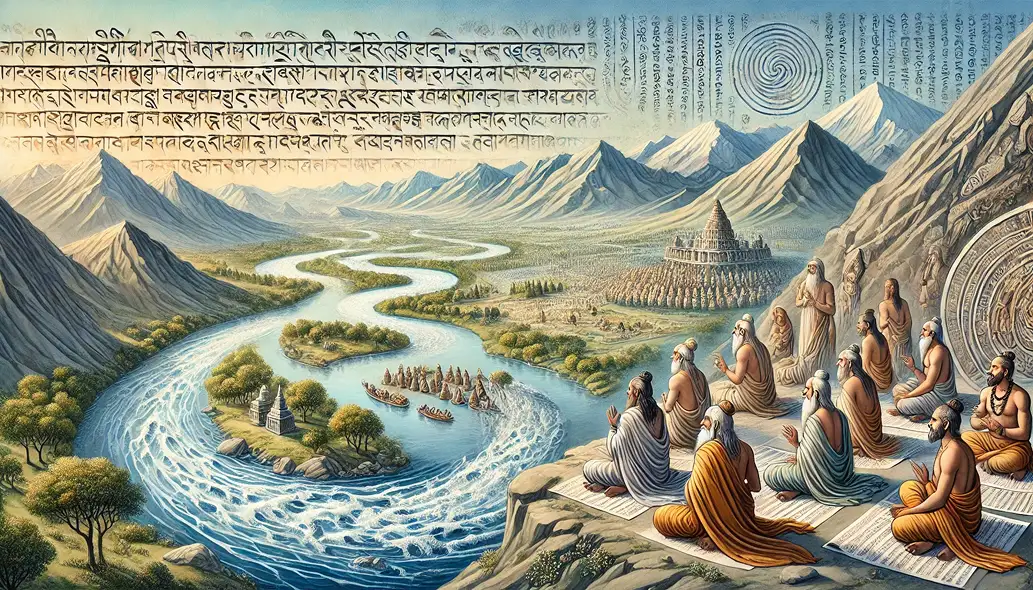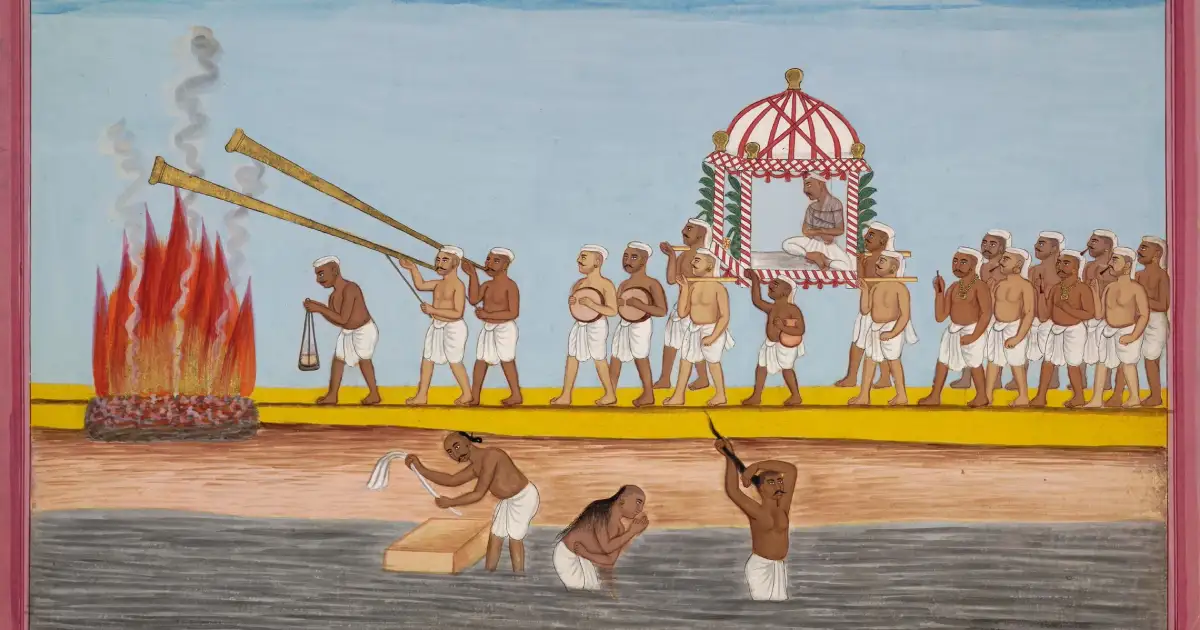The following is some elaborate freethinking on history, deep history, and the macro-historic trajectories of species, civilization and consciousness. I am brought to these views varyingly by hard evidence, leading synchronisms, reasoning, furious self-debating, bold speculation, and everything in between. The idea is to distill a paradigm of history, formed over the past few decades of engagement with it. To begin-
It Exists
Yes, a linear view of time and history is now laughably outdated.
Yes, the historicist and chronological enterprises trace their origins to specific imperatives borne of desert cults.
No, they cannot be used as universal tools of investigation.
But equally is it true that the universe possesses an unmistakable arrow of time. It may spring back epoch to epoch, it may turn direction over cosmic eons, it may wrap on itself much like the ouroboros snake - but these are so far removed from the perceptions of ape consciousness that they may as well not exist. There is of course a place for nuanced, metaphysical and profound views of time, but equally legitimate is a place for model-building within the identifiable and demonstrable properties of this universe. To use the former as an excuse to avoid the latter is a copout. Even the measuring tape that spends most of its time recoiled into itself serves its purpose when laid out flat and uncoiled.
What we’re pointing to above is the ontological distinction between a ‘really real' view of reality and the ‘salient upon our existence' factualities of it. This is fundamental and important to detail:
Reality A
The 'really real' view includes, for example, bands of sound and light outside of our perception. It includes dark matter and junk DNA, and also things we do not know that we do not know. It is a humbling reminder of our limited place in the scheme of things, an affirmation of what McKenna called “the mystery out there."
Reality B
The ‘salient upon our existence' reality is that which we are able to observe, determine, document, understand, etc., such that it constitutes human knowledge. It is, by definition, a smaller subset of the 'really real' view.
Without insisting on the analogy overmuch, and speaking reductively, we could parse Reality A as matters of the ādhibhautika and ādhidaivika layers, while Reality B is confined to and equipped to comment upon the realm of the bhautika layer only.
The former will forever be just beyond our reach, regardless of how far we stretch our striving reach. A god of never-quite-ending gaps, an insurmountable gap in the completion of human knowledge. The latter in the meantime, is present, perceivable, potent, salient, and incorrigibly conspicuous. I belabor this point because of frequent encounters with simple dismissals of Reality B, by airy allusions to Reality A. But it is no revelation to point that there are limits to human understanding; and that it will always be limited, in the larger scheme of things, is no argument for surrender in the midway. Crucial to understanding this is being aware of the exclusivity of categories. The mystic, transcending and high rising potential of humanity has always tapped into Reality A, and curious intellectualism into Reality B may never deliver to us comparable epiphanies and insights. But we are not here to bluster on utilities and futilities; we are simply laying out factualities, or perhaps more the contours of our landscape. In other words-
Reality B exists, period. How useful its study is, or how futile such an enterprise in the face of the promised nirvāṇā(s) of a pursuit for Reality A - are matters for normative domains. Reality B exists, positively, period.
As might be obvious to the keen reader by now, this has a deep consequence on issues of Hinduism and Indian history. Most prominently, it flares up in ways:
- On the matter of Vaidika 'history,' and the affront it allegedly commits to the apauruṣeya and anādi nature of Vaidika knowledge.
- On the matter of 'dating' Rāma and Kṛṣṇa, allegedly disrespectful to the divinity and avatāra stature they carry within Hindu tradition.
How Sanātana, if History?
Resolving the above 2 conundrums is in fact remarkably simple, for they are no conundrums at all. To begin, since we are not investigating on the plank of Reality A, we are making no comments on belief, devotion, cultural wisdom, ontology or praxis. Intellectual honesty demands that any queries approaching these must be directed to śāstrika experts or the wisdom of self-realized seers, or failing these - to the altar of humility at the least.
But notice the obvious-
Inquiries into Vaidika history are investigations on the mortal, human and time-bound ṛṣis who perceived the eternal wisdoms. They ask not 'when was this knowledge certifiably first discovered.' Rather, they wonder - 'when can we say the ṛṣis articulated their insights in the mantric syntax we see in the Ṛgveda,' or 'can we glean any details on this matter at all?' This is affirmed by a luminary no less than Jagadguru Śrī Chandrasekharendra Saraswati ji in his magnum opus Hindu Dharma, where he compares the nature of Vaidika knowledge to gravity.
Gravity is as old as the universe, and its existence was independent of Isaac Newton's discovery of it. He simply expressed an eternal truth in the specific syntax of mathematics and algebra. Gravity in this analogy is anādi and apauruṣeya. But Newton veritably mortal, his coordinates in time quite well known.
Similarly, the utility of the Vaidika corpus is not in the prizes it may win in contests of historical primacy, but in the transcendent and eternal insights it contains. These insights are independent of human discovery and perception. The ṛṣis merely expressed them in the specific metric and mantric syntax we call Vaidika Saṃskṛta. And these ṛṣis, their life and times, the evolution of their own thought and wisdom - all of these are are as human and time-wrapped as our own dates of birth, the years we spent in study or a given job, the places we went to, the people we befriended or antagonized, the companions we found or lost - and more.
To deny all of this is an unwitting disservice to the ṛṣis and ancestors that have sustained these practices. We would effectively be removing them from time, the fact of their having existed and lived placed into a timeless limbo, disallowed from asserting its presence in any records of materiality.
In short, while we cannot ‘date' Vaidika knowledge, and we can humbly cede that to tradition itself it transcends time; in the realms of Reality B, we can very well ask worldly, mundane and laukika questions about the people who revealed this sacred knowledge to us. The Gāyatrī Mantra is eternal, but let us not remove Viśvāmitra and subsequent Gāthinas from their rightful place in human annals. Indeed, one of them even confirms that he sings older songs anew - confirming himself to be a part of the same time-continuum we occupy.
The same reasoning gets us far even on the matter of Rāma, Kṛṣṇa, divinity, and avatāra. But here, it's tradition itself that gives us vehement support. For consider what an avatāra means - a 'descent.' Of what, from what to what? Of divinity, from transcendent realms to this one, our laukika and known universe. Put another way, an avatāra is veritably the descent of divinity from its usual perch pervading Reality A, to a very specific spacetime coordinate located in Reality B. If we dismiss the second half of this, what does it even mean to say, ‘Rāma avatarita huey thhe'?
So - projects to date the epics, or assertions of specific janmatithis and chronologies, are affirmed as epistemologically valid by tradition itself. Once again - it is entirely correct that the value of the Rāmāyaṇa is on matters of divinity, human religious experience and practice, pauruṣārthika wisdom, and more. But here, we are simply establishing the point that curiosities and investigations into Reality B are neither ontologically flawed nor traditionally discordant. Ancestors, firmly relocated back in time.
So history exists, and Hindu history exists as much as any other. But there's a problem-
We Know Nothing
Here's something most curious. Broadly put, the modern homo sapiens (us) has been around for at least 3,00,000 years. ‘Modern' homo sapiens implies exactly as much cognitive, emotional, and reasoning ability as any of us might muster today; and our kind of intelligent ape has been roaming earth for a very long time. Further, we are likely not even the first human beings. Ancestral species before us might have been fully sapient as well - implying as much complexity of individual and society as exists in us. Now, consider the theories forwarded for how we might have invented the wheel and organized agriculture -
Wheel
Young children are often encouraged in history classes to introspect on their own intuitions. A round object moves easier, of course! Ancient humans might have noticed the boulders that easily roll down hills, or been struck by tumbleweeds sauntering across the open plains. Ignore how simplistic this is. Instead, ask the question few ask - if modern human beings have been around for at least 3 lakh years, how is it that this obvious intuition did not occur to any bright sapien till within the last ~10,000 years? Why did this most obvious invention await the Holocene era for its fateful intersection with humanity? For 2,90,000 years, the homo sapien dully gazed at rolling boulders and tumbling weeds, nary an intuition to be found?
Agriculture
The general speculation is such - early humans were nomadic, moving from one place to another, season to season. Sometimes they would return to the same regions in the same seasons - living in a kind of shifting durbar system where cooler locales were preferred in the summer months and sunnier ones made the winter months tolerable. In one such tribe, in one fateful season, a human noticed wild grain growing exactly where the tribe had discarded seeds in the previous season. And viola! Agriculture was born. Armed with the observable fact that seeds thrown into the soil could yield whole new plants in a few months, the homo sapien was now ready to conquer the entire planet.
But again, ask the silent question that echoes loud. For 2,90,000 years humans migrated in nomadic bands, undoubtedly discarding seeds in each season - locale after locale, generation after generation. And yet, only in the Holocene era did one proto sherlock notice the causation in the correlation? Only in the last 10,000 years did Farmer Zero arise, his/her powers of observational reasoning forever changing human destiny?
Simply put - the true history and past of humanity runs both deeper than we can gaze and more complicated than we cognize.
In any case, using material technologies and discoveries to appraise how ‘civilized' or ‘advanced' ancient humanity was is itself a dubious metric. For example, we know for a fact that merely 2,000 years ago the inhabitants of India exercised a far greater mental and memory capability than we do today. Only a generation or two ago, people routinely learnt multiple classical languages, and read widely in all of them. We need not go too far back in time to find cleaner food, healthier lifestyles and most importantly - communally fulfilling social structures - that would put our modern social forums and support group coping mechanisms to shame. Of course technology is a scale, and certainly humanity has sprinted quite far on this scale in recent centuries. As much as we may lament the pitfalls of social media and the oligarchies of big Tech, we love our shiny toys, our cyber realms and that delivery within 5 minutes guarantee.
But technology is only ONE scale, and it is no mysticism to point out that its efficacy in the true fulfillment and flourishing of a human is double-edged at best, disastrous at worst.
This point is important, because speculations into past eras of humanity, wiped out civilizations, Atlantis, and manvantaras are routinely dismissed for being technologically incongruous. The evidence of the Holocene speaks for itself; and prior to its onset, humanity purposelessly hunted and gathered for tens of thousands of years (not to speak of our Denisovan, Neanderthal, and other cousins).
But in reality, humanity may have indeed witnessed multiple eras and epochs, some scoring high on various scales of complexity, culture, civilization, and material prosperity. While this does not allow us to speculate carelessly and fantastically, it forces us to be humble in our dismissals of bold new discoveries, or at least less arrogant in our assertions of ‘Holocene myopia'.
What I Think I Know
Human history runs deep, and has seen several cycles of civilizational rise and fall. In fact, civilization is NOT a scaling problem - it is a sustaining problem. Consequently, human inquiries into reality and streams of knowledge are indeed ‘sanātana' - running so inscrutably back in time that they seem to have ‘always existed', i.e., anādi and apauruṣeya.
But time is real, critical paths are discernible, real humans commit real deeds that mark history, and a glass does not crack before it slips off the table. That is, the emergence of cultural motifs, the crystallizations of knowledge - these and other cultural milestones have distinct and inter-sequentially referential positions in humanity's story.
Take the example of mūrti pūjā. At some point before the first human coaxed a Deva to embody a previously inert rock for the first time - a la prāṇa pratiṣṭhā - a preceding human might have simply venerated a stone with ritual attachment, but sans Deva embodiment. That is, the stone precedes the mūrti. And a curiosity into plausible milestones in this journey is neither logically flawed nor chronologically misplaced - it is in fact a study into the very emergence of culture and civilization. This is better understood through a comparison-
What is memory? Why is it important? Can there be a continuing sense of ‘self' without an accompanying and unbroken stream of memory, each impression accumulating over an existing base? Why can we look back at events, experiences, and incidents in our life to acquire new insights, epiphanies or inspirations for our current and present life? Each node in our memories is salient upon the next. We use our pasts to inform ourselves in the present and empower the shaping of our future.
More to our context, this means it's important that in the first manvantara, Svāyambhuva Manu and his people were already worshiping Devī and Sūrya, i.e., these practices were passed-down tradition even to them. But they were not the only people around. There were “fellow Indians" in violent disregard of their ways. The collective memories and traumas formed in that era informed the next ones, and accumulated into a passed down legacy of incessant battles between hostile tribes. But these are the stories of boring, near-condescending, historiography.
More profoundly, they tell us the ingrained ways and customs that a Śukrācārya and Bṛhaspati had to overturn, in getting Devas and Asuras to meet over the manthana. It tells us of the immense civilizational contribution of a Vasiṣṭha, who “innovated" a union of upāsanās and proclaimed Indra and Varuṇa to be equally strong, in times of conflict between tribes that took one as totemic and another as destructive.
We can understand better the Paurāṇika Indians' concerns over rāja dharma and the upholding of duty, for they knew of many kings gone bad, many epochs taken by dust, entire civilizational trajectories nullified by singular adhārmika kings, and also of the few luminaries that exemplified a better way to do things - the best way to do things. This is how duty becomes dharma, truth becomes aspirational, cultural pride and passage becomes paddhatī, and so on. Without chronology, we wouldn't know that the dhārmika bull stood on all fours once, its condition steadily deteriorating such that it’s propped tentatively on one foot now. There would be no arrow to our lives, to the collective journeys we take through life and time.
Without a sincere nod to the FELT REALITY of Reality B, pray, what songs would we sing when we reconvene in Reality A?
Out of India, and Back to It
I'm fascinated by the 'others' - ancient high civilizations that no longer exist, but would have once been contemporaneous to periods of Indian civilization. Imaginations of Egyptian Book of Dead readers conversing with austere Indian Vedāntins are all the more colored by the lack of any real details to channel them. What would the first-contacts of those eras have looked like? How did pre-bronze-age caravan riders of Balochistan come to trade lapis lazuli with coastal desert dwellers of Bahrain? What was it about the ancient world, that made the Greeks who learnt of Kṛṣṇa immediately analogize him to Herakles? And what happened with the advent of desert monotheisms that fatefully eradicated this pure essence from the world?
I have come to believe in the following broad course of events (not to the exclusion of other events elsewhere of course):
1- The earliest that Hindu memory can reach, remembers a period of long forming and storming before the norming and performing. The Purāṇas condense this as A) 14 wars between Devas and Asuras, and 2) The migration out of India by Priyavrata and his descendants. It implies a long and sustained period of tribal bands migrating out of India, in different numbers at different times in different directions. In the historical record, the first we can plausibly locate this is with emigrating Dānava tribes - after losing wars to Devas.
2- The fault lines developed in above eras continued till we reach what can be termed the proto-Vaidika and Vaidika eras - the epoch when tribal memories of Deva and Asura bands had become epic legends, and forgotten military commanders were resurrected through divinities now being invoked. The Śakra leader becomes the commanding Indra. The wretched villain Vṛtra is evoked by Dāsa Śambara. This multivariate, amorphous shape changing of memories to legend, of legend to myth, and the reimagination of myths into divine shapes being newly discerned - is a real and relevant path of civilizational development.
3- This offends, or at least unsettles many. Was Indra a divinity then? Or merely a tribal chieftain? Did he start as the latter but become the former? Or something else entirely? Such questions CANNOT ever be certifiably answered.
Is it really too implausible, that humans encountering and experiencing novel divinities, novel transcendental engagements, consciously and unconsciously pulled from known lore? That the first Indian that met with a divinity for the first time, unbidden thought of it as a valorous ancestor returned, or an epic hero manifested?
Did a primeval ascetic glance upon a Himalayan peak, discern a curious shape to the snow in its high crevices, and design the Om symbol? Or did the symbol come first, the mountain’s uncanny snow patterns a later discovery? Did Om Parvat determine a script, or did a script define an entire mountain for generations to come?
Perhaps Śakra came first, and the thunderous deity later encountered was called Indra in his honor. Or perhaps the deity animated future visions and past memories in a cosmic Mandela effect kind of way. Old legends then became his past avatāras. His appearance among the mortals an event of every age?
4- What's important here is the chronological ordering which the civilization has cared to remember. There were neolithic tribes first (in our collective sense of selves), and pursuits of prosperity often hindered, sabotaged and set back. From this was coaxed out a praxis for engagement on a higher plane, a contact established with entities from beyond the spacetime matrix. This is when things began to change.
5- Dharma. Dhriyate iti loko anena. Established, sustained. Where? In this realm. It is the collective, inter-generational mission to reflect Reality A in Reality B. Prakṛti in Saṃskṛti. Agar kuch baat hai ki hasti mit-ti nahi humaari, toh kaise na romanchak ho aise amartya ki kahaani? To say it is all because of Dharma is tautology. The question is not how dharma kept us going - the question is how and why we strived to keep dharma alive. Just like the fascinating tale of a precious stone is revealed by he who seeks it out. It is the seeking that makes the stone precious.
6- Waves after waves out, till we reach the Indo-Europeans. Vaidika era. The tribes of the Ṛgveda - Ānavas, Bhāratas, Auśinaras and many, many more. A well documented and chronicled era of outward migrations. It is these outgoing Ānavas who will trigger a fated march towards delusion, aka monotheism.
7- Vasiṣṭha's attempts fall vain in Ānava practices. Despite his great hymns reconciling Varuṇa and Indra, the proto-Iranians reject Indra. Varuṇa, Asura Medha, becomes their God - Ahura Mazda. Indra relegated to a lower demon.
8- Many more centuries pass. Late stage Ānava fire hymnology becomes Zoroastrianism. Still more centuries. Zoroastrianism mutates into Manicheism.
9- The further away from the homeland they go, it seems, the more they stray into darkness. Jyotirmā tamasogamaya. By the time they reach Arabia, sab ke sab radicalized ho gaye.
10- Anatolia was gone. Egypt was gone. Greece was dwindling. A desert truly. Emerged monotheism proper. Judaism, Christianity and Islam are the creole creations of descendants of those that refused to join the civilizational Agni. The fathers rejected Indra. The sons developed a bigotry of belief. The grandsons fooled themselves into thinking they found the one true god. A part of me is sympathetic - for what would a desert dweller do, if not mistake the mirage for an oasis?
11- In a different part of the planet, savagery retook time, for a long time. When the Purāṇas speak of “the worship of devas stoppingand the “recitation of Vedas ending, resist the temptation to find literal implications. Culture degrades as a people move away from its innovative core. It rusts as generations are long on the move. When survival takes precedence, the passage of stories from old ones to young ones suffers first, and the inculcation of wisdoms eschewed, if grudgingly. This is well known -
12- Dhvaṃsana and Avadhvaṃsana. Disintegration, and the staving off of it. The first is the norm, the usual way of things. Like the clay that would splatter outwards from a potter's wheel, were he to be negligent. Avadhvaṃsana, the staving off of it, is a continuous vigilance. Not only is it well known, it is semantically and ontologically embedded deep. At the root of ‘dharma' is the dhātu ‘dhṛ', which means - avadhvaṃsana! Dharma is the way to maintain an equilibrium in the face of a world constantly given to dhvaṃsana. It is a quest for harmony.
13- The lost children of defeated adhārmikas eventually returned. Villains now, monstrous in their iconoclasm. Perhaps Vasiṣṭha was too lenient, when he counseled Sagara to exile defeated tribes instead of decimating them. Even thousands of years later, chickens may return to roost.
Such is the long arc of history, and they say chronology is useless. Out of time, our ancestors. Out of memory, our civilization then.
End of Part 1
